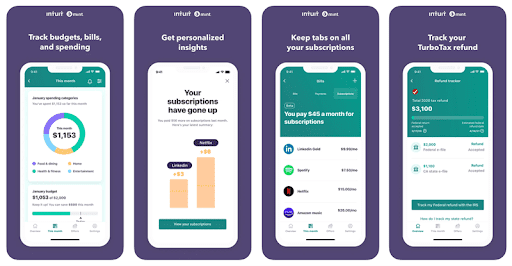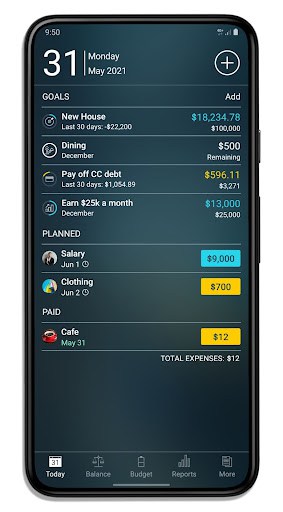![]() Mobile apps play a key role in simplifying our lives. From shopping for clothes to purchasing groceries, everything can be done through a mobile application. The process of managing your personal spending is not untouched by this digital revolution—if you can buy it, you can track it with an app.
Mobile apps play a key role in simplifying our lives. From shopping for clothes to purchasing groceries, everything can be done through a mobile application. The process of managing your personal spending is not untouched by this digital revolution—if you can buy it, you can track it with an app.
The increasing pace of technological advancements has brought numerous expense tracking apps to the market. Forbes unrolled a list of the top money management apps for 2022 in the USA. Most of these apps have the ideal framework, features, and subscription plans to inspire Americans to make good use of them for managing their cash flow.
Expense tracking apps are perfect for people who need help managing their personal finances, especially since apps automate the process. (No rocket science required!)
If you are thinking of developing an expense management app, I’ve got you covered. Ahead, you’ll read about some top reasons for developing an expense tracking app along with some vital features.
Not to mention, you’ll gain insight into the overall expenditure for creating expense tracking app development software.
Why Expense Tracking Apps Are Required
You might be thinking, “There are so many expense tracking apps on the market that track real-time cash flow. How can my expense tracker compete?”
And I’m here to tell you, “That’s true!” But I’ve also come fully armed with some concrete suggestions for you.
There are numerous money management apps on the Google Play Store and Apple App Store. Most of them have thousands of downloads and ratings of three stars and above.
So, how will your app lock horns with its potential competitors?
This is a question that many app developers encounter. It is not easy to overpower competitor apps instantly. A good place to start is with something ‘extra’, like features that surpass the standards that have been already set. Breaking this barrier may reduce the competition.
But, application features are not the limit. Other factors like performance and stability also play key roles in determining the success of the expense tracking app.
Let’s consider the example of calculating expenses. Tracking the inflow and outflow of finances becomes simplified when done digitally. Manual calculations were curbed when expense trackers were introduced in the market.
The user can now synchronize data, add and delete as they please, and, above all, keep everything secure. Decorated with different features, the popularity of expense management apps in business has risen tremendously.
Prime Features To Include in an Expense Tracking App
Bankrate reports that 63% of Americans use at least one expense tracker for managing their budget. Users crave expense tracking apps with features that allow business and personal finance management to run smoothly.
People seek a budgeting app that offers free registration and includes all the essential features that summarize expenses.
Before proceeding to the list of the features that should be integrated in your expense tracking app, let’s look at some standard features that all money management apps include. Users need to be able to:
- Add new records quickly with an intuitive and easy-to-use interface
- See their spending distribution on an easy-to-read chart or get detailed information from the records list
- Safely synchronize using their own Google Drive or Dropbox account
- Access their spending tracker easily with handy widgets
- Backup and export personal finance data in one click
- Save money with a budget tracker
- Use multiple accounts
Apart from the common features above, there should be some unique features too. These key features will help your app stand out from its competitors in the market.
Existing fintech apps can give you some ideas. You may want to integrate a new feature that could be missing in the fintech apps that are currently active in the market.
Let’s take a look at some prominent features of a money management application.

Data Security
Expense tracking apps should always safeguard the data of their users. Since such an app usually contains details and information related to the user’s bank accounts and debit/credit cards, they are often targeted by hackers.
Thus, the security of a fintech app should never be compromised. Developers should integrate a multi-tiered authentication process, data encryption, firewalls, and smart cloud computing solutions to mitigate the risk.
When the risk factor is reduced, the user feels safe while using the app knowing that all their information will remain confidential.
Report Generation
Report generation is one of the key features of a money management app. Budgeting apps help to keep expense-related data organized with balance sheets, profit and loss statements, etc.
Also, the data remains safe on cloud storage. Be it bill invoices or payment receipts, individuals can retrieve them as required.

Credit Score Tracking
Another significant feature of an expense tracking app is tracking credit score. When a credit card is linked with the expense tracker app, it syncs the account information and provides the credit score of the user.
The expense tracking app provides weekly/monthly credit reports along with suggestions to improve the credit score. When users have a good or excellent credit score, they get rewarded when bills are cleared on time.
Monitoring the Budget
Wouldn’t it be amazing if your expense tracking app could tell you when you’re overspending? Money management apps with a budget tracking feature can help in gaining insights into income and expenses.
If the expense of an individual is exceeding the real-time set limit, the app will notify the user and suggest the expenses that could be reduced.
Biometric Recognition
Passwords and PINs used to be the common methods for unlocking an app, but with the technological upgrade, biometric recognition became popular. It is a method where an expense tracking app can be accessed using just a fingerprint.
Many expense tracking app developers are integrating the biometric feature in mobile applications. It is solely being done to enhance the security of the user’s data.
AI Integration
By integrating artificial intelligence (AI), future expense timelines can be predicted. Judging the expense behavior, a report on expense fluctuation, savings, and more can be generated, which can be fruitful for users with different expense behaviors.
Streamlining Tax Deduction
Budgeting apps are evolving as new features are being introduced. Since users need to file taxes, they need to maintain a surplus sheet. Expense trackers with a tax category feature can categorize the expenditure into a relevant tax category automatically.
The Cost of Building an Expense Tracking App
Developing an app that provides expense reporting and is pre-loaded with the various features discussed above demands both effort and time.
Since an expense tracker is built using different features, it becomes vital to consider different factors:
- App Features: Integrating new features or upgrading existing features
- Platforms: Is the expense tracker developed for a single platform or cross-platform (iOS/Android)?
- Third-party Integrations: The number of third-party APIs integrated for supporting the service
- Testing Stage: The number of phases of testing the app will go through
- Maintenance & Support: The annual maintenance and support charges for the app
Popular Expense Tracking Apps in 2022
Not every personal finance management app is suitable for everyone. Users have different requirements related to savings, expenses, and investment. To simplify the process of choosing the right app, we have compiled a list of some popular expense reporting and real-time money management apps.
Developers can assess these apps—right from the wireframe to the functionalities and loopholes—and create an even better version.
Mint
Mint is an expense management app created by Intuit. The app is equipped with budgeting tools and a credit monitoring service that can be used by investors, self-employed, and salaried individuals alike.
Mint can be linked with different banks and credit card providers if users have an account with a small financial institution. It has more than 10 million users worldwide.
Honeydue
Honeydue is a financial management app for couples. This expense tracker was acquired by Mission Lane and helps a couple to plan their budget as required. The couple is required to sync their bank accounts and credit card details for financial planning. As of May 2022, Honeydue has over one million global users.
Simplifi
Simplifi, by Quicken, is an expense tracking app. It makes the list owing to its budget cash flow tracking tools. It offers a personalized expense plan with real-time updates. Users can get the expenditure plan by adding their bank accounts within the app. Simplifi has over one million users globally.
Pocket Guard
If you’re a spendthrift and wish to cut unnecessary expenses, the Pocket Guard app is perfect for you! This app has an algorithm that tracks daily income and expenses. The app works when the user connects their bank account and credit card details.
The app generates a monthly report along with savings goals that help cut unwanted expenses. Pocket Guard has 10 million users as of May 2022.
The Bottom Line
Personal finance management app development is not rocket science. You just need the right tech stack and a list of features that will help the app stand out from the competition.
To compete with similar apps, expense tracking app developers are now focusing on the features discussed above. Those particular features are now seen in a handful of fintech apps and will soon become increasingly popular in the fintech world.
